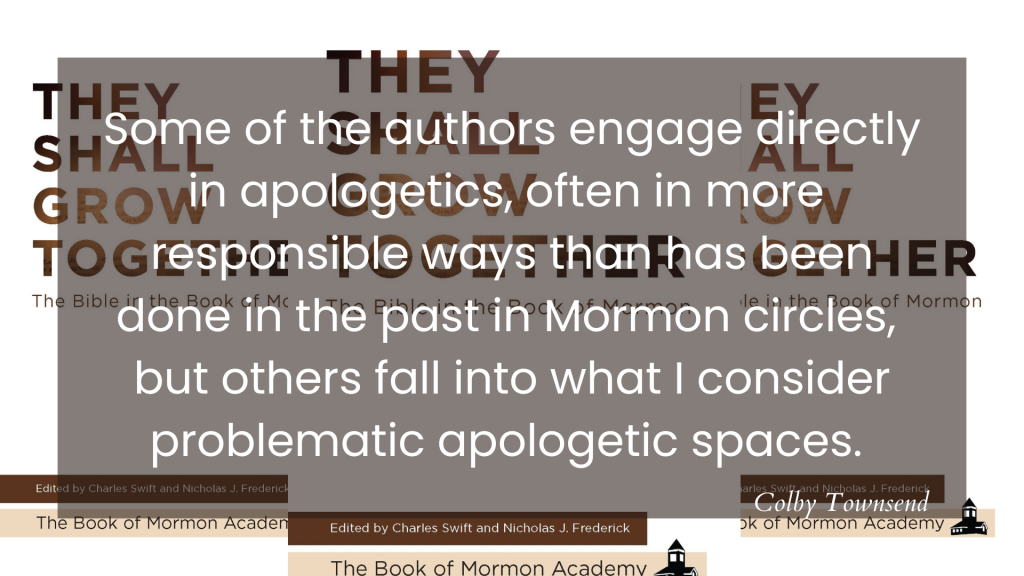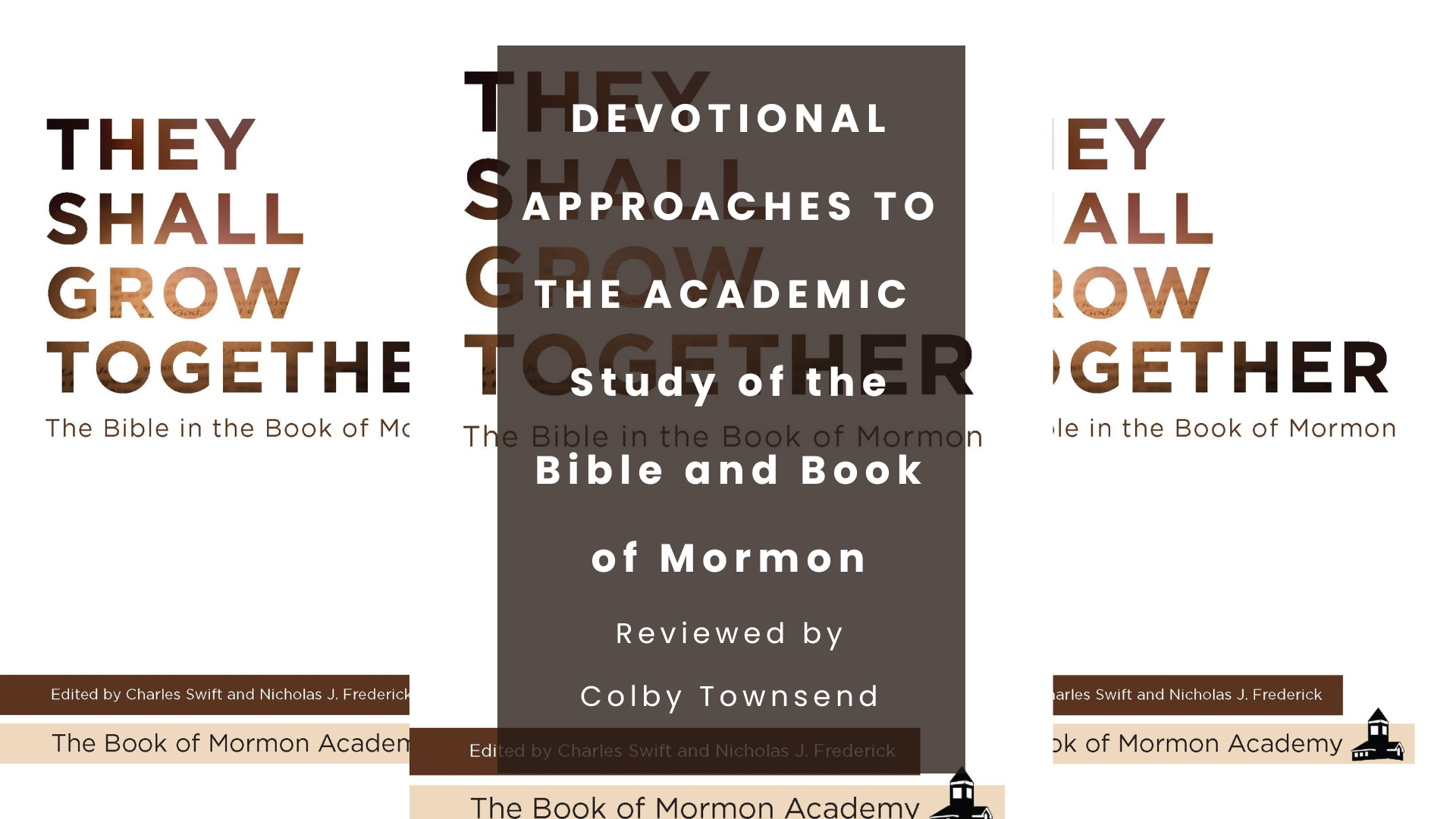Articles/Essays – Volume 58, No. 2
Devotional Approaches to the Academic Study of the Bible and Book of Mormon | Charles Swift and Nicholas J. Frederick, eds., They Shall Grow Together: The Bible in the Book of Mormon
This collection of essays is the fourth volume in the Book of Mormon Academy Series from the Religious Studies Center at Brigham Young University. Earlier volumes focused on Abinadi, Ether and the Jaredite records, and Samuel the Lamanite. This volume brings together fifteen essays of varying sizes and quality. These essays look at a variety of aspects that connect the biblical world to the Book of Mormon or analyze how the Book of Mormon takes up biblical themes or ideas, or quotes, alludes to, or echoes direct text from identifiable sources within the King James Bible. The essays throughout the volume have a devotional setting in mind from beginning to end and are thus not going to be of interest to scholars working in broader fields of American religion unless they are studying how scholars within Mormonism approach issues relating to how the Book of Mormon engages with the Bible and related topics. Some of the essays demonstrate deep engagement with biblical studies and knowledge about the field, while others are only superficially aware of the scholarship. For the most part, though, this collection deals with questions relevant to an educated Mormon audience and tries to provide answers specifically to academically minded members of that reading audience.

Some of the authors engage directly in apologetics, often in more responsible ways than has been done in the past in Mormon circles, but others fall into what I consider problematic apologetic spaces. An example of the latter is an essay that continues the apologetic attempt to explain the “skins of blackness” that the Lamanites receive as a curse after Laman and Lemuel are separated from Nephi and his group. These attempts to explain away the text and create an alternative explanation are problematic for many reasons, but in this attempt, Jan J. Martin creates out of whole cloth a scenario where Lamanites gave themselves tattoos. This deals more directly than much previous scholarship in academic Mormon circles with the fact that the Lamanites are described not as wearing dark clothing—which at least one previous essay has argued—but as having dark skin (and often only wearing “a short skin girdle about their loins” [Enos 1:20], so not much clothing at all). The problem here, like this previous argument, is that the explanation shifts the one doing the action of the curse from God to the Lamanites, rather than God cursing the Lamanites with something that then continues through each generation, implying an inherited trait through bloodlines. The description in the Book of Mormon follows far more closely the rhetoric surrounding interracial marriage, what would later come to be called “miscegenation.”[1] Although similarly problematic, at least previous iterations of this argument were grounded in the text. For her argument, Martin makes up an entire series of possibilities about how Lamanites came to give themselves tattoos and why Nephite authors never mentioned them. The main impetus for these kinds of apologetic arguments seems to be an attempt to remove the Book of Mormon from the racism inherent in most early American literature, and thereby distance the book from its historical context. It is unclear to me whether or not Martin is aware that portraying global Indigenous communities’ practices of tattooing in this light similarly racializes the practices that she describes (i.e., by connecting them to a curse). Criticizing this essay is also somewhat uncomfortable because it highlights another weakness of the volume: This is the only standalone essay, in a book of fifteen essays, that is written by a woman. The only other woman in the volume wrote with a male co-author.
There are some essays in this volume that I think will be of interest to scholars that study the reception history of the Bible in Mormon circles. Daniel L. Belnap’s essay delves deeply into how some authors of the Hebrew Bible conceptualized execution and the implications execution, especially of being hung on a tree, had for understanding the individual’s status with deity. Belnap’s writing is dense and welcome reading in the context of Latter-day Saint work on the Bible in the Book of Mormon. In another example, Nicholas J. Frederick examines how some of the texts attributed to Paul appear throughout the Book of Mormon in subtle ways, rather than through lengthy quotations. This is incredibly important work, since some recent scholarship on the study of Isaiah in the Book of Mormon has cast doubt on scholars’ abilities to do exactly this kind of work (i.e., identifying more subtle uses of a range of biblical passages in the Book of Mormon).[2] I think this volume will be one that BYU undergrads, grads, and alumni who have an interest in scholarly study, mixed with a heavy portion of devotional argumentation and evidence, will find interesting. There were times, though, in my reading experience where I had to wonder if the authors were mostly writing to each other, their colleagues, and the leadership in BYU’s Religious Education department more than any other audience.
Charles Swift and Nicholas J. Frederick, eds. They Shall Grow Together: The Bible in the Book of Mormon. Provo: Religious Studies Center, Brigham Young University and Deseret Book, 2022. xxii + 500 pp. Hardcover: $29.99. ISBN: 9781950304301.
[1] Elise Lemire, “Miscegenation”: Making Race in America (University of Pennsylvania Press, 2002), 4.
[2] Joseph M. Spencer, A Word in Season: Isaiah’s Reception in the Book of Mormon (University of Illinois Press, 2023), 7, 226n30.


 Back to full Issue
Back to full Issue

